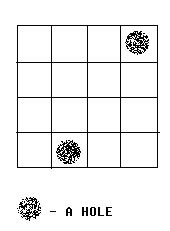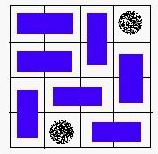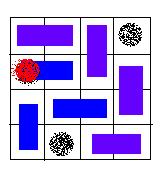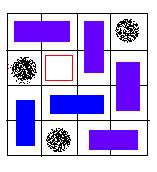Description
Alice and Bob often play games on chessboard. One day, Alice draws a board with size M * N. She wants Bob to use a lot of cards with size 1 * 2 to cover the board. However, she thinks it too easy to bob, so she makes some holes on the board (as shown in the
figure below).

We call a grid, which doesn’t contain a hole, a normal grid. Bob has to follow the rules below:
1. Any normal grid should be covered with exactly one card.
2. One card should cover exactly 2 normal adjacent grids.
Some examples are given in the figures below:

A VALID solution.

An invalid solution, because the hole of red color is covered with a card.

An invalid solution, because there exists a grid, which is not covered.
Your task is to help Bob to decide whether or not the chessboard can be covered according to the rules above.

We call a grid, which doesn’t contain a hole, a normal grid. Bob has to follow the rules below:
1. Any normal grid should be covered with exactly one card.
2. One card should cover exactly 2 normal adjacent grids.
Some examples are given in the figures below:

A VALID solution.

An invalid solution, because the hole of red color is covered with a card.

An invalid solution, because there exists a grid, which is not covered.
Your task is to help Bob to decide whether or not the chessboard can be covered according to the rules above.
Input
There are 3 integers in the first line: m, n, k (0 < m, n <= 32, 0 <= K < m * n), the number of rows, column and holes. In the next k lines, there is a pair of integers (x, y) in each line, which represents a hole in the y-th row, the x-th column.
Output
If the board can be covered, output "YES". Otherwise, output "NO".
Sample Input
4 3 2 2 1 3 3
Sample Output
YES
#include <iostream> #include <cstdio> #include <cstring> using namespace std; #define maxn 38*38 bool vis[maxn],map[38][38]; int first[maxn],marry[maxn]; int vv[maxn*4],nxt[maxn*4]; int e,m,n,k; int heng[] = {0,0,1,-1}; int zong[] = {1,-1,0,0}; void addEdge(int u,int v) { vv[e] = v; nxt[e] = first[u]; first[u] = e++; } void createmap() { for(int i = 1;i <= m;i++) { for(int j = 1;j <= n;j++) { if(map[i][j]) continue; for(int k = 0;k < 4;k++) { if(!map[i+heng[k]][j+zong[k]]) { addEdge((i-1)*n+j,(i+heng[k]-1)*n+j+zong[k]); } } } } } bool dfs(int u) { for(int i = first[u];i != -1;i = nxt[i]) { int v = vv[i]; if(!vis[v]) { vis[v] = 1; if(!marry[v] || dfs(marry[v])) { marry[u] = v; marry[v] = u; return 1; } } } return 0; } int main() { //freopen("in.txt","r",stdin); while(scanf("%d%d%d",&m,&n,&k)==3) { memset(first,-1,sizeof(first)); memset(map,0,sizeof(map)); memset(marry,0,sizeof(marry)); for(int i = 0;i <= n+1;i++) { map[0][i] = map[m+1][i] = 1; } for(int i = 0;i <= m+1;i++) { map[i][0] = map[i][n+1] = 1; }//这两个for循环是将地图封闭起来。 for(int i = 1;i <= k;i++) { int x,y; scanf("%d%d",&x,&y); map[y][x] = 1; } e = 0; createmap(); int ans = 0; for(int i = 1;i <= n*m;i++) { memset(vis,0,sizeof(vis)); vis[i] = 1; if(!marry[i] && dfs(i)) ans++; } if(ans*2+k == n*m) printf("YES\n"); else printf("NO\n"); } return 0; }





















 865
865

 被折叠的 条评论
为什么被折叠?
被折叠的 条评论
为什么被折叠?








